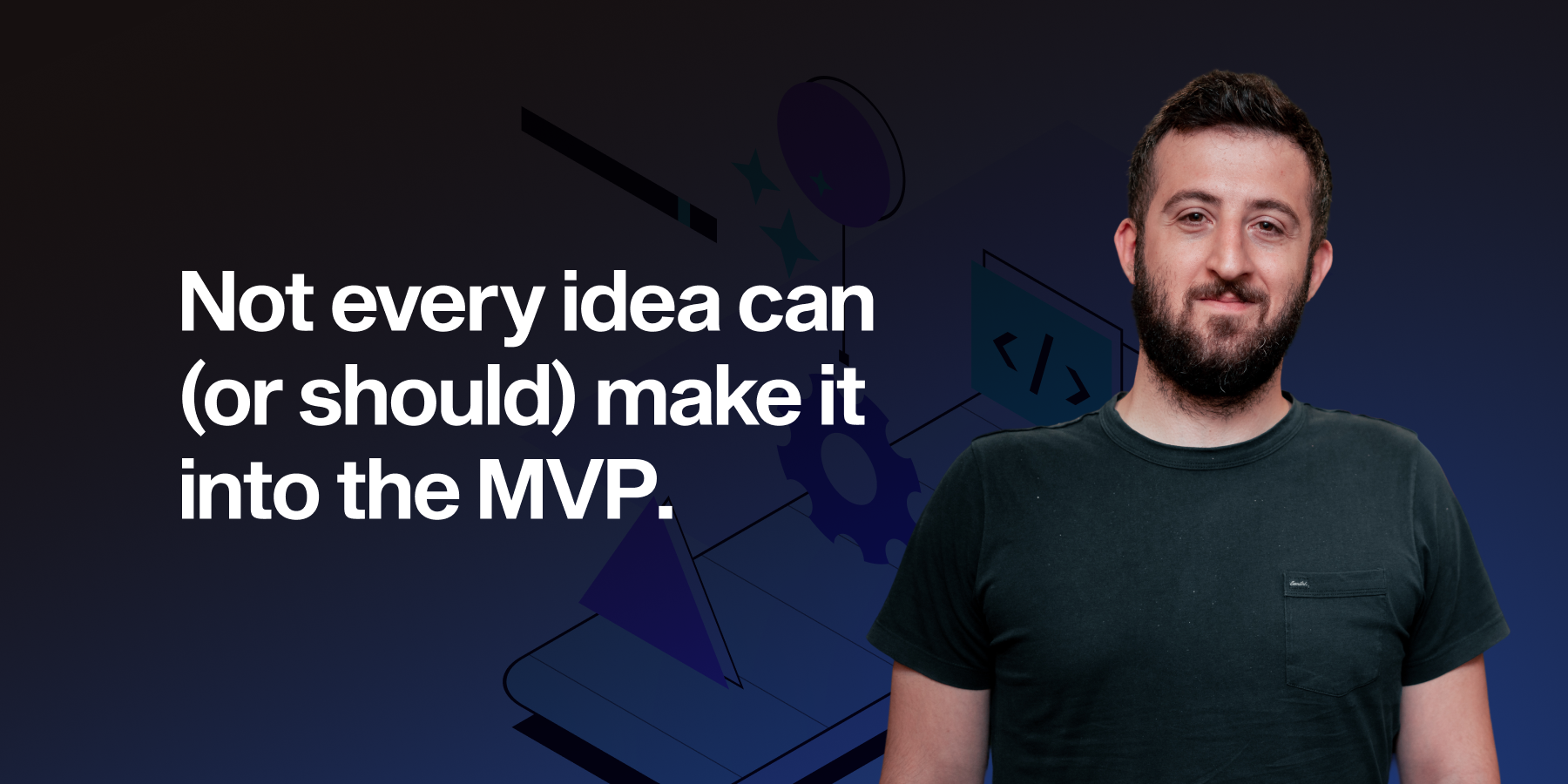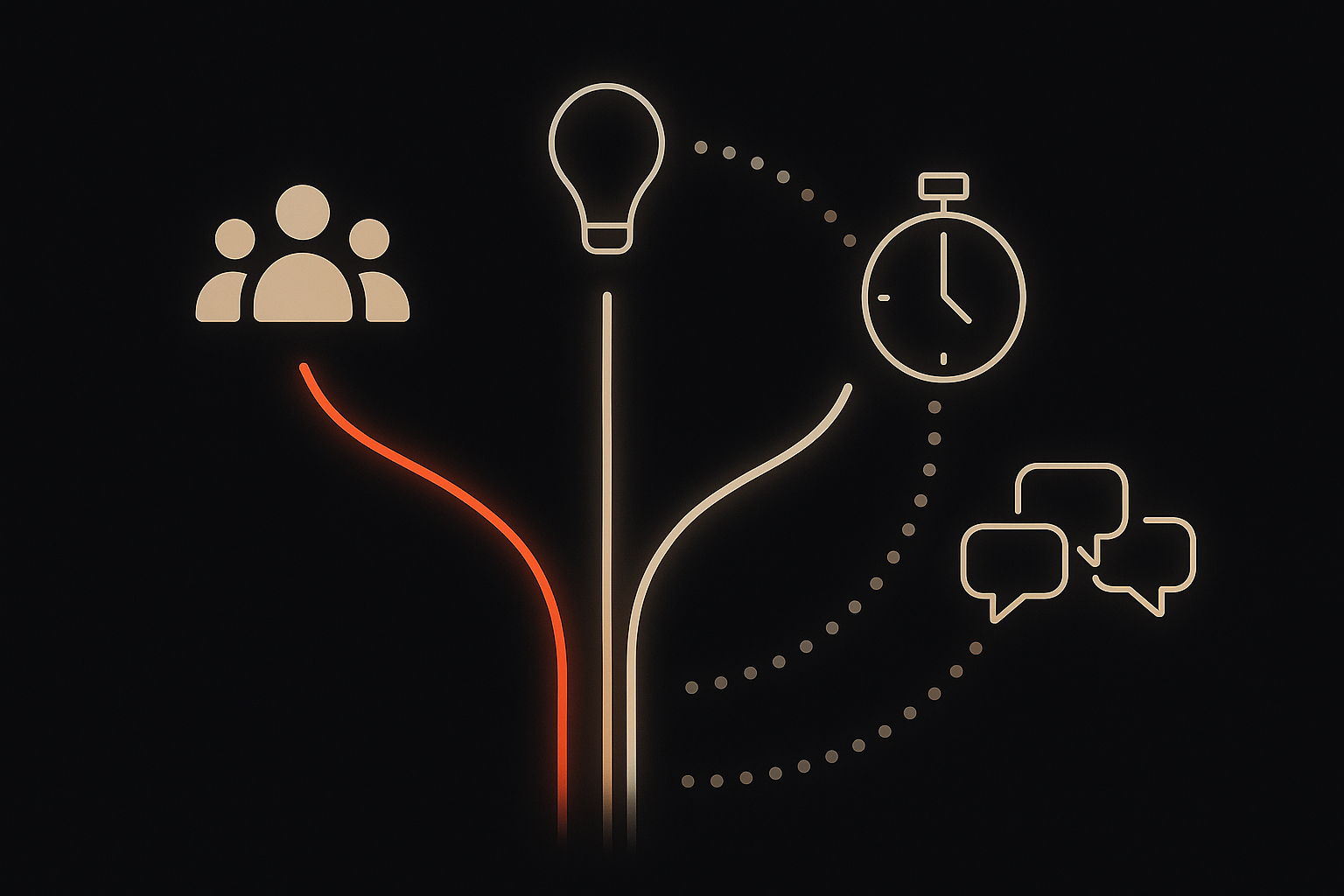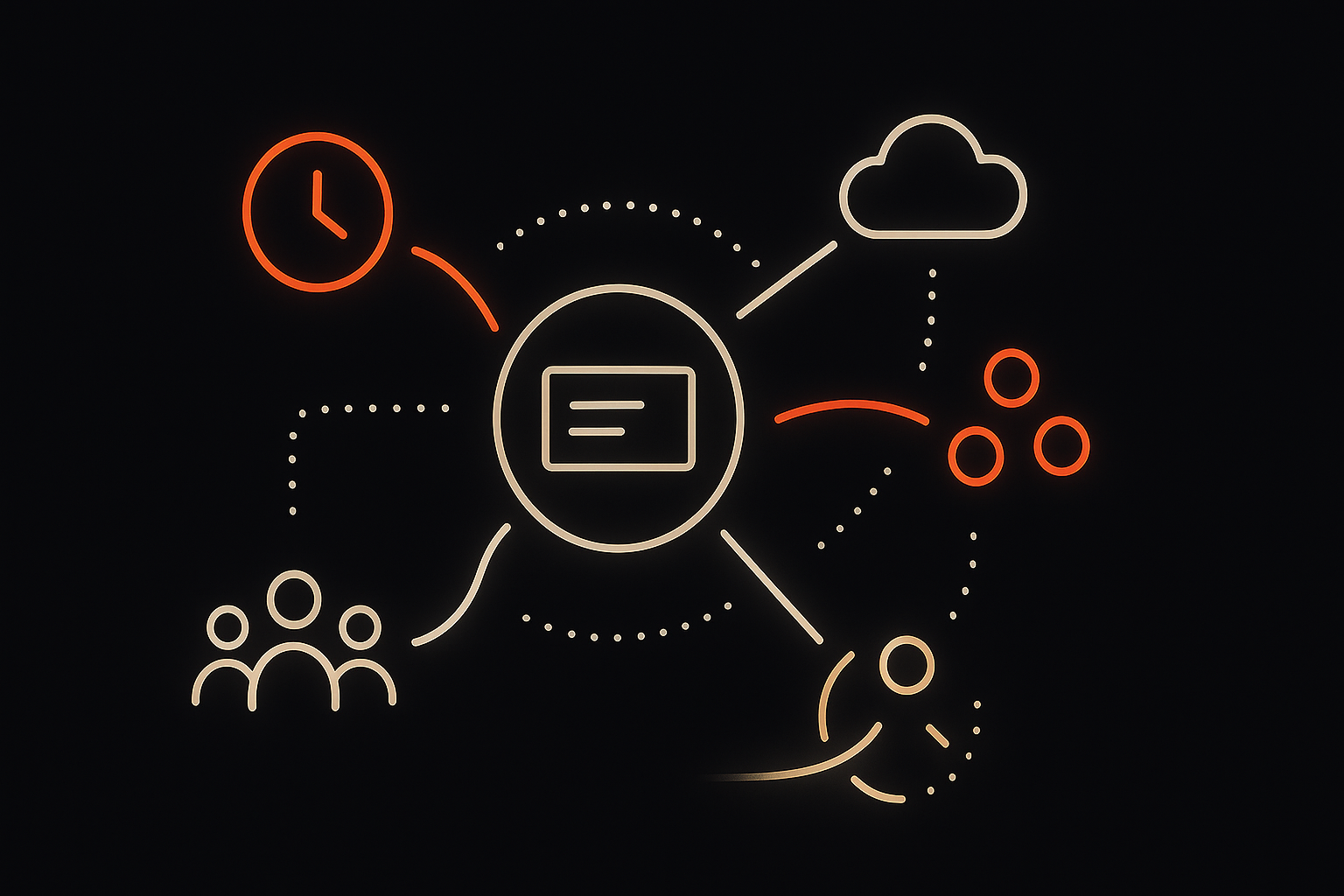How to Run Discovery & Design Workshops That Turn Ideas Into MVPs

Every successful digital product begins with a clear vision and a deep understanding of the problems worth solving. For tech founders and CTOs navigating complex product decisions, our structured ideation and discovery workshops create measurable business value - reducing development cycles by up to 30% and increasing feature adoption rates.
When our technical teams collaborate directly with stakeholders in these facilitated sessions, we transform abstract requirements into actionable specifications, eliminate costly assumption-based development, and create shared accountability for outcomes. These workshops function as strategic inflection points where technical constraints meet business objectives, producing roadmaps that align engineering reality with market opportunity.
In our experience working with over 100 founders from all over the world, our guided collaborative frameworks consistently transform uncertainty into executable plans that technical teams can immediately implement.
How We Define Client Ideation and Discovery Workshops
We structure our client ideation and discovery workshops as focused sessions where teams and stakeholders work together to generate and refine ideas. We design these as guided brainstorming meetings with specific activities that encourage open collaboration.
In the ideation phase, we focus on creating new solutions. We encourage participants to share thoughts freely, using methods that prioritize quantity and variety of ideas over immediate judgment.
Our Discovery component involves exploring the context of the problem first. We make sure to understand user needs, business constraints, and technical realities before jumping to solutions.
We integrate both parts into a single session. This approach helps us avoid assumptions and keeps ideas grounded in real challenges and opportunities.
Why Our Workshops Drive Product Success
Our client ideation workshops create an environment for quick decision-making. When we gather stakeholders in one place, discussions move faster and questions get answered in real time.
These sessions help our product teams spot risks earlier and make changes before development begins. This reduces uncertainty and prevents problems that might surface later in the project.
Key benefits we deliver:
- Faster alignment: Everyone participates in the same discussion, reducing misunderstandings.
- Reduced development risks: Problems get identified before coding begins.
- Clearer priorities: Teams leave with specific next steps instead of vague directions.
For our clients, these workshops provide ideas based on actual user needs rather than assumptions. Clients also participate directly in the process, creating shared ownership of decisions and outcomes.
Our Preparation Checklist Before Inviting Stakeholders
We know good workshops start with careful preparation. The work we do before the session determines whether participants leave energized or frustrated.
Align on Goals and Success Criteria
We host pre-workshop calls with key stakeholders to clarify expectations. We document the specific outcomes everyone wants - prioritized concepts, defined experiments, or alignment decisions. This gives everyone a clear target.
Conduct Rapid User Research
We collect existing user insights, pain points, and behavioral data. We create simple user personas and journey maps to bring real user context into the workshop. This prevents teams from designing for themselves instead of actual users.
Curate a Cross-Functional Participant List
We select participants from different roles: client stakeholders, end users, technical leads, and designers. We keep the group between six and eight people to maintain active participation and manageable dynamics.
Our ideal participant mix:
- Client decision-makers: People who can approve ideas and allocate resources
- End users: Individuals who will actually use the product
- Technical leads: Developers who understand what's possible to build
- Designers: People focused on user experience and interface design

Craft and Share the Agenda Early
We send a detailed timeline with planned activities, expected outputs, and time limits. We include any pre-work assignments like reading materials or data reviews. This helps participants come prepared and reduces time spent explaining basics during the session.
Frameworks We Use in Discovery & Design to Build Winning MVPs
Once the immediate next steps are defined, we rely on proven frameworks to bring structure and clarity to the discovery process, ensuring every idea is grounded in real business and user value.
Instead of relying on generic brainstorming exercises, our Discovery and Design phase applies structured, fast-paced techniques tailored to early-stage product decisions. These frameworks help validate assumptions, refine direction, and reduce ambiguity before a single line of code is written.
- Lean Canvas: We use Lean Canvas to capture the entire business model on a single page. This forces clarity on customer problems, value propositions, and revenue streams without getting lost in lengthy documents. It helps founders and teams visualize assumptions side by side, making it easier to spot weak areas early. By the end of the exercise, everyone has a shared, testable picture of how the product will succeed in the market.
- User Journey Mapping: User Journey Maps allow us to step into the shoes of real users and trace their interactions across every touchpoint. Instead of designing in a vacuum, teams can see where friction occurs and where moments of delight can be engineered. This makes complex flows - onboarding, daily use, or critical actions - much easier to align with real user behavior. By visualizing these paths, we ensure the product experience feels seamless and intuitive from the start.
- Clickable Prototypes: We build high-fidelity, clickable prototypes that let stakeholders and end-users “test-drive” the product before development begins. These interactive models transform abstract concepts into something tangible, making feedback far more precise than verbal opinions. By validating design choices early, we dramatically reduce the risk of rework during coding. The prototype becomes a shared reference point, aligning business, design, and technical expectations.
- Prioritization Frameworks: With dozens of ideas on the table, prioritization frameworks like MoSCoW or RICE ensure choices aren’t made on gut feeling alone. These methods structure discussions around what’s essential, what’s nice-to-have, and what can wait. The result is a clear, defensible product backlog that reflects both user value and business strategy. This helps teams avoid scope creep and stay laser-focused on delivering the MVP.
- Design Sprint-Inspired Sessions; Our sessions borrow heavily from the proven Design Sprint model but adapt to MoP’s 2/4-week Discovery and Design timeline. We combine divergent idea exploration with convergent decision-making, keeping momentum high without sacrificing depth. This approach empower our teams to test multiple directions quickly, then converge on the strongest solution with data-backed confidence. By compressing this into focused workshops, we accelerate clarity and cut weeks off the decision cycle.
Other Frameworks That May Drive Breakthroughs in Discovery & Design
Different brainstorming techniques work better for different types of problems and personality types. Some other approaches you can implement to increase the chances of breakthrough thinking are outlined below.
Brainwriting
Have each person write down ideas independently and silently for 5-10 minutes. Then everyone shares their ideas with the group. This reduces the influence of loud voices and captures input from quieter participants.
Worst Possible Idea
Ask participants to intentionally suggest terrible solutions to the problem. These bad ideas often reveal hidden assumptions and can lead to unexpected directions when reversed or adjusted. Sometimes the "worst" idea contains the seed of the best solution.
Method 6-3-5
Arrange for six participants to each write three ideas in five minutes, then pass their sheet to the next person. This continues until everyone has contributed to each sheet. The method rapidly multiplies and evolves concepts through collaboration.
SCAMPER Remix
Use the SCAMPER technique to provide specific actionable prompts that help teams systematically modify existing ideas or products. This structured approach forces creative thinking beyond initial concepts and consistently produces breakthrough variations that wouldn't emerge from unstructured brainstorming:
Substitute: Swap one element for another alternative
Combine: Merge two or more elements to create something new
Adapt: Adjust existing ideas from other contexts to fit the current problem
Modify: Change the size, shape, or other characteristics
Put to other use: Find new applications for existing elements
Eliminate: Remove non-essential parts
Reverse: Consider what happens if order or roles are flipped
Our Frameworks to Prioritize and Select Winning Ideas
Not every idea can (or should) make it into the MVP. To ensure teams focus on features that deliver the highest value, we rely on prioritization frameworks that balance clarity, speed, and impact.
Moving from many ideas to a focused shortlist requires systematic evaluation. At MOP, we prefer lightweight, practical frameworks that help teams make decisions quickly and transparently reducing bias and aligning everyone on what matters most.
- MoSCoW Prioritization: Our go-to framework is MoSCoW, which organizes ideas into four groups: Must have, Should have, Could have, and Won’t have. This simple structure makes scope discussions much more productive by forcing clear trade-offs. Teams leave with consensus on what truly defines the MVP and what can safely wait for later iterations. Because of its clarity and speed, MoSCoW is the foundation of most prioritization work we do.
- RICE Scoring: When more detail is needed, we sometimes apply the RICE method, scoring ideas on Reach, Impact, Confidence, and Effort. This adds a quantitative lens, making it easier to compare different types of features fairly. RICE is particularly useful when stakeholders bring strong opinions, because it shifts the conversation from gut feeling to structured data.
- ICE Framework: For rapid decisions, especially in earlier stages, we use the simpler ICE scoring system (Impact, Confidence, Ease). It allows teams to quickly rank ideas without the overhead of more complex models. ICE is not always necessary, but when speed is critical, it helps ensure decisions are still grounded in logic rather than bias.
By tailoring the framework to the situation - MoSCoW for clarity, RICE for depth, and ICE for speed - we ensure prioritization supports both immediate alignment and long-term product success.
Our Hybrid and Remote Facilitation Tools for 2025
Remote and hybrid workshops require different tools than in-person sessions. We've found the right digital tools can actually improve collaboration by providing structure and eliminating some common facilitation challenges.
Miro AI Templates
We use pre-built templates that leverage artificial intelligence to organize and group ideas automatically. The AI-assisted clustering saves time during synthesis and helps identify patterns humans might miss.
FigJam Breakout Timers
We utilize built-in timers and breakout functions to help structure activities and keep smaller groups focused during remote working sessions.
Voting and Feedback in Small Groups
Rather than using anonymous voting apps, we focus on direct, personal feedback. In live sessions, voting happens in the room; in remote workshops, we go around the table to hear from each participant. Because our groups are intentionally small, this approach works faster and more transparently. Most importantly, it reinforces psychological safety - everyone should feel comfortable sharing their view openly, otherwise the workshops lose their purpose.
Butter for Energy and Breaks
We incorporate engagement tools like music, reactions, and planned energizer activities. Structured breaks prevent participant fatigue during longer design sprint sessions.

How We Manage Group Dynamics and Ensure Inclusive Voices
Every group has different personalities and communication styles. Our skilled facilitators recognize these patterns and adjust their approach to ensure productive collaboration.
When dominant personalities take over conversations, we acknowledge their contributions, set time limits for speaking turns, and use structured rounds so everyone gets equal airtime.
For quiet participants who may prefer listening or hesitate to share ideas aloud, we create opportunities for silent idea generation, use round-robin formats where each person speaks in turn, or provide anonymous input methods like digital voting.
When off-topic discussions threaten to derail workshop momentum, we acknowledge interesting points, record them visibly on a "parking lot" board, and assign specific time to revisit these ideas later. This maintains focus while ensuring all contributions get documented.
How We Turn Workshop Outputs Into a Validated Roadmap
Our workshops generate lots of ideas, sketches, and notes. We create real value by turning these materials into actionable plans that development teams can execute.
We document all decisions made during the workshop. We consolidate artifacts like sticky notes, sketches, and digital boards in one accessible location. We transform top ideas into user stories with clear acceptance criteria that define when each story is complete.
We create validation experiments to test ideas before building full products. These might include rapid prototypes, concierge tests where team members manually deliver the service, or Wizard-of-Oz tests where parts of the experience are simulated to observe user reactions.
We establish clear handoffs to development teams with assigned owners, specific deadlines, and milestone tracking. We define governance structures to guide decision-making as products move from concept to delivery.
So: ready to transform your product vision?
Frequently Asked Questions About Our Client Ideation Workshops
How long do our client ideation and discovery workshops last?
Our most effective sessions run four to six hours with structured breaks every 90 minutes. This timeframe supports both generating diverse ideas and narrowing them down to priorities while preventing participant fatigue.
How many people do we include in ideation workshops?
We aim for groups of six to eight participants for idea exploration workshops. This size provides diverse perspectives while maintaining an environment where everyone can actively contribute to discussions.
What happens when our client workshops fail to generate viable ideas?
When workshops don't immediately produce implementable ideas, we still extract important insights about user needs, technical constraints, or market realities. These learnings frequently lead to breakthrough solutions in follow-up sessions or different approaches to the original problem.